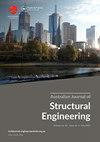Wooden bridges with deck of sawn board and round beams: main orientations
IF 1.3
Q4 ENGINEERING, CIVIL
Australian Journal of Structural Engineering
Pub Date : 2020-12-26
DOI:10.1080/13287982.2020.1862968
引用次数: 1
Abstract
ABSTRACT The county of Itapeva – SP, Brazil, has a great territorial extension, with many vicinal roads and, consequently, many wooden bridges with some type of problem. This research had the purpose of analysing 34 wooden bridges, with decks formed by natural longitudinal beams connected to the sawn transverse boards, to identify the main problems presented and proposition of solutions. The great majority of the analysed bridges (82.35%) presented a small span (up to 15 m), and the analysed spans ranged from 5 m to 44 m approximately. The lack of of preservative treatment was a problem for all analyzed bridges and this is a great factor that contributes to the reduction of the lifetime of the bridges. As a result of this work, the main construction and calculation recommendations for wooden bridges are presented. Two pre-sizing tables are also presented to guide builders and other interested parties in the construction of wooden bridges, in order to obtain secure structures, low cost and with guaranteed durability.木桥与锯板甲板和圆梁:主要方向
巴西Itapeva - SP县的领土面积很大,有许多公路,因此有许多木桥存在某种问题。这项研究的目的是分析34座木桥,这些木桥的甲板由天然纵梁连接到锯断的横向板,以确定存在的主要问题和解决方案。绝大多数(82.35%)桥梁为小跨度(小于15 m),分析跨度约在5 ~ 44 m之间。缺乏防腐处理是所有分析桥梁的一个问题,这是一个很大的因素,有助于减少桥梁的寿命。在此基础上,提出了木桥的主要施工和计算建议。为了获得安全的结构、低成本和保证耐久性,还提出了两个预尺寸表,以指导建筑商和其他感兴趣的团体建造木桥。
本文章由计算机程序翻译,如有差异,请以英文原文为准。
求助全文
约1分钟内获得全文
求助全文
来源期刊

Australian Journal of Structural Engineering
ENGINEERING, CIVIL-
CiteScore
2.50
自引率
0.00%
发文量
31
期刊介绍:
The Australian Journal of Structural Engineering (AJSE) is published under the auspices of the Structural College Board of Engineers Australia. It fulfils part of the Board''s mission for Continuing Professional Development. The journal also offers a means for exchange and interaction of scientific and professional issues and technical developments. The journal is open to members and non-members of Engineers Australia. Original papers on research and development (Technical Papers) and professional matters and achievements (Professional Papers) in all areas relevant to the science, art and practice of structural engineering are considered for possible publication. All papers and technical notes are peer-reviewed. The fundamental criterion for acceptance for publication is the intellectual and professional value of the contribution. Occasionally, papers previously published in essentially the same form elsewhere may be considered for publication. In this case acknowledgement to prior publication must be included in a footnote on page one of the manuscript. These papers are peer-reviewed as new submissions. The length of acceptable contributions typically should not exceed 4,000 to 5,000 word equivalents. Longer manuscripts may be considered at the discretion of the Editor. Technical Notes typically should not exceed about 1,000 word equivalents. Discussions on a Paper or Note published in the AJSE are welcomed. Discussions must address significant matters related to the content of a Paper or Technical Note and may include supplementary and critical comments and questions regarding content.
 求助内容:
求助内容: 应助结果提醒方式:
应助结果提醒方式:


